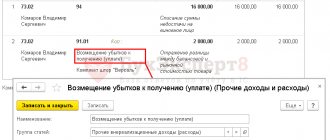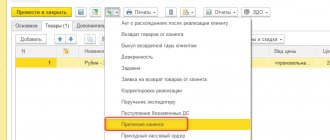Basic rules for deducting and recovering VAT
In terms of goods received by the VAT payer (as well as for other values), the Tax Code of the Russian Federation establishes the right to a tax deduction for this tax (clause 1 of Article 171). The deduction will not raise questions if the following conditions are simultaneously met in relation to the goods:
- subsequent transactions with it are supposed to be carried out with VAT (clauses 1, 2 of Article 171 of the Tax Code of the Russian Federation);
- goods are reflected in accounting (clause 1 of article 172 of the Tax Code of the Russian Federation);
- there is an invoice issued by the supplier (clause 1 of Article 169 of the Tax Code of the Russian Federation), or a document (customs declaration) confirming the fact of payment of tax upon import into the Russian Federation (clause 1 of Article 172 of the Tax Code of the Russian Federation).
The Tax Code of the Russian Federation obliges the restoration of a tax previously accepted for deduction in quite unambiguous situations (clause 3 of Article 170), including when the product with which the tax is associated:
- contributed to the management company or mutual fund (subclause 1, clause 3, article 170);
- is involved in operations not subject to VAT (subclause 2, clause 2, article 170);
- changes its value downward (subclause 4, clause 3, article 170);
- subsidized by the budget (subclause 6, clause 3, article 170).
For more information about which transactions are classified as non-VAT taxable, see the article “Transactions not subject to VAT taxation: types and features.”
Is it necessary to restore VAT when writing off a defect? Find out the answer to this question in the ConsultantPlus ready-made solution. If you don't have access yet, get a free trial online.
If surpluses are identified during the annual inventory in 2009
Since all organizations carried out the next annual inventory in October - December 2009 and the inventory results were reflected in the accounting for 2009 (at the latest - on December 31, 2009), and the new rules are in force only from January 1, 2010, for many The question arises: what is the correct way to deal with the surpluses identified during this inventory?
In our opinion, the answer to this question depends on the moment at which the excess data is written off (used or sold).
If excess materials identified during the annual inventory carried out at the end of 2009 were used in production or sold back in 2009, the accountant only had to rely on the old rules.
In other words, for tax purposes in 2009, it was necessary to increase non-operating income by the market value of the identified surplus, and then it was necessary to recognize as part of material expenses (if the materials were released into production) or write off as a decrease in income from the sale of surplus materials only the amount corresponding the amount of income tax on the market value of capitalized surpluses.
Example 5 . During the annual inventory in December 2009, excess padding polyester was discovered at the warehouse of Vista LLC, the market value of which was 6,000 rubles. All synthetic padding was released to the workshop and used in production in the same month - December 2009.
In such a situation, the accountant reflected the transactions in accounting and tax accounting in December 2009 as follows:
Debit 10 Credit 91
6000 rub. — surplus padding polyester was capitalized;
Debit 20 Credit 10
6000 rub. — padding polyester was released into production (the market value of surplus padding polyester capitalized as a result of inventory was written off when used in production).
In tax accounting in December 2009, non-operating income on the basis of clause 20 of Art. 250 of the Tax Code of the Russian Federation were increased by the same amount as in accounting - by 6,000 rubles.
But the material costs do not include all 6,000 rubles, but only the amount corresponding to the amount of income tax, calculated on the basis of the market value of surplus inventories capitalized and used in 2009, in the amount of: 6,000 rubles. x 20% = 1200 rub.
If the property, recorded before December 31, 2009 as surplus, identified as a result of an inventory carried out in October - December 2009, is actually released into production or transferred to the buyer already in 2010, for example in January 2010, it is non-sales. income in the amount of the market value of the capitalized surplus, of course, should have been recognized back in 2009, but it is necessary to generate material expenses in 2010 or reduce income from the sale of surplus materials in 2010 according to the new rules, for the entire market value of the data materials.
Example 6 . Let's change the conditions of example 5 and assume that the surplus padding polyester was not used in production in December 2009, but was sold to another enterprise in February 2010 for 8,260 rubles, including VAT - 1,260 rubles.
In this case, the accountant should reflect the transactions in accounting and tax accounting as follows:
In December 2009
Debit 10 Credit 91
6000 rub. — surplus padding polyester was capitalized.
In tax accounting in December 2009, on the basis of clause 20 of Art. 250 of the Tax Code of the Russian Federation the same amount - 6000 rubles. — recognized as part of non-operating income.
In February 2010
Debit 62 Credit 91
8260 rub. — income from the sale of surplus padding polyester is reflected;
Debit 91 Credit 68
1260 rub. — VAT was charged on the sale of surplus padding polyester;
Debit 91 Credit 10
6000 rub. — the sold padding polyester was written off (at the cost at which it was capitalized based on the inventory results in December 2009);
Debit 91 Credit 99
1000 rub. (8260 - 1260 - 6000) - the financial result from the sale of surplus padding polyester is written off at the end of the month.
In tax accounting in February 2010, income from the sale of padding polyester (excluding VAT, in the amount of 7,000 rubles) is reduced by the market value of this padding polyester at the time of capitalization of the surplus based on inventory results, that is, by 6,000 rubles.
Consequently, taxable profit as a result of the operation of selling surplus padding polyester increases by 1000 rubles. - just like in accounting.
The logic of the Federal Tax Service on the issue of VAT restoration
In answering the question about the need to restore VAT on written-off goods, the Federal Tax Service and the Ministry of Finance have long assumed that write-off, regardless of the reason for which it occurs (shortage, damage, obsolescence), is not an operation subject to this tax. Accordingly, according to the text of paragraph 2 of Art. 170 in such a transaction, the tax must be included in the cost of the product being written off. That is, if VAT was deducted upon receipt of goods from the supplier, then at the time of write-off it must be restored and included in expenses.
This position is confirmed by repeated letters from the Russian Ministry of Finance:
- dated January 21, 2016 No. 03-03-06/1/1997 - VAT on goods written off must be restored and taken into account according to the rules of Art. 170 Tax Code of the Russian Federation;
- dated 03/19/2015 No. 03-07-11/15015 - since disposal due to damage is not subject to VAT, a deduction for the written-off product is impossible;
- dated 07/05/2011 No. 03-03-06/1/397 - the procedure for writing off goods is not subject to VAT, and therefore the tax on such goods should be restored;
- dated 04/24/2008 No. 03-07-11/161 - write-off of goods in excess of the norms of natural loss requires the restoration of VAT in the part of its value corresponding to the excess of the norms.
But by now we can say that the position of officials has changed. And the reason for this is numerous judicial practices not in favor of tax authorities, which the financial and tax departments order to be followed (letters of the Ministry of Finance of Russia dated November 7, 2013 No. 03-01-13/01/47571, Federal Tax Service of Russia dated November 26, 2013 No. GD-4-3 / [email protected] ).
So, first, the Federal Tax Service, in a letter dated June 17, 2015 No. GD-4-3 / [email protected] , said that there is no need to restore the tax in the event of loss of property as a result of an emergency. And already in 2021, the Ministry of Finance indicated that there was no obligation to restore VAT upon disposal of property as a result of a fire (letter dated 03/02/2018 No. 03-03-06/1/13389). Both departments referred to the decision of the Supreme Arbitration Court of the Russian Federation dated October 23, 2006 No. 10652/06.
Writing off shortages during inventory counting - instructions
General write-off procedure
It is possible to write off the company's shortfalls if the following conditions are met:
- For the one year in which the inventory was carried out.
- One person responsible for carrying it out.
- Goods or property of the same name.
- Goods or property in identical quantities.
You should follow specific instructions and follow these steps:
- Receive a write-off order from management.
- Write off the credit as a debit to account 94 “Shortages and losses from damage to valuables.” Write off the residual value of fixed assets, the cost of materials and finished products, and the purchase price of goods.
- In addition, the DT account should be sent to the transportation costs and employee payments spent on the inventory.
- After receiving a calculation of the norms of natural loss from the accounting department, compare the total amount of expenses with the norms. If the amount is less than the EU norm, then it can be written off as company expenses.
- We deal with VAT. There are two ways - to restore VAT and reflect the required amount on debit as credit, or not to restore it.
Write-off when guilty
If there are culprits due to whom the shortage arose, and also if the amount of the shortage is greater than the norm of natural loss of the company, then the person responsible for the inventory follows the following instructions:
- Orders the accountant to write off the amount of the shortfall from the credit to the debit.
- Carefully checks documents that should indicate the difference between the market and actual value of goods.
- Together with the accountant, he calculates the amount that amounts to material damage to the organization.
- Transfers data to company management, who carry out explanatory work and, if necessary, go to court.
Write-off without culprits
When the guilt of the officials is not proven, the person responsible for the inventory must be notified - he will receive a letter with the court decision. Based on this document, the shortage can be written off to the same debit of the company's expenses.
If the official’s guilt is proven, but he disappeared, then the shortage is written off at the expense of net profit.
The position of the judiciary regarding restoration
As we said above, the judicial authorities, which are approached by taxpayers who enter into disputes with the Federal Tax Service regarding the non-compulsory restoration of VAT on a written-off product, strongly support the position of such taxpayers. Its rationale is based on the fact that in the list of situations requiring tax restoration (clause 3 of Article 170 of the Tax Code of the Russian Federation), the write-off of goods is not named. Therefore, if all the conditions for the previous deduction have been met, the reality of the existence of the product and the need to write it off are confirmed, then VAT restoration is not required. An example of such decisions can be the decisions of the FAS:
- Central District dated February 24, 2016 No. F10-43/2016;
- Ural District dated 02/08/2016 No. F09-203/16;
- North Caucasus District dated 05/07/2014 No. A32-18211/2012;
- Northwestern District dated 02/03/2014 No. A42-74/2013;
- Moscow District dated December 25, 2013 No. A40-34818/13;
- East Siberian District dated 03/05/2013 No. A19-1816/2012;
- Moscow District dated December 27, 2012 No. A40-120001/11-20-499;
- Ural District dated October 19, 2011 No. F09-6671/11.
This approach was repeatedly supported by the Supreme Arbitration Court, which was reflected in the decisions:
- dated May 19, 2011 No. 3943/11;
- dated October 21, 2009 No. VAS-13771/09;
- dated June 21, 2007 No. 7016/07;
- dated October 23, 2006 No. 10652/06.
In inv 3 the price is indicated with or without VAT
» Tula, st. Soifera, vil. Address: Tula, Sovetsky district, st.
1 person is registered at the place of residence. The starting price for the sale of property, excluding VAT, is RUB .00. Tula, st. Soifera, d. Contacts Shortages identified.
How to keep them. If shortages are identified as a result of the inventory, they must be compensated by the employee.
Filling out the inventory list. Identification of surpluses. We issue an inventory list to our commission for conducting an inventory. The accounting data is filled in there. During the inventory, the commission checks the quantity and enters the data in the actual indicators column. Questions: 1. The commission checks the quantitative availability of inventories; should the commission fill out the column with the amount in the inventory if it does not check it?
When surplus is identified, it is necessary to determine the market value of the found inventories as a result of inventory and capitalize them in the books.
The market value in this case is determined on one of the dates: on the day of signing the inventory report or on December 31. How to fill out the accounting inventory list in this case? Consequently, if there is data on the price of a unit of inventories, the inventory commission enters the quantity in the columns on actual availability, and fills in the amount by calculation based on the cost per unit of inventories according to accounting data.
As for the market value, in order to accept surpluses for accounting and to reflect their value as part of tax revenues, a separate Calculation of market value or Certificate of market value from the appraiser can be issued later and additionally attached to all inventory documents.
Possible options for taxpayer behavior
Despite the fact that officials seem to have decided on the issue of restoring VAT on write-off goods, it is impossible to completely exclude the occurrence of disagreements with inspectors during inspections. Therefore, the taxpayer still has to make his own decision about whether to restore the tax in such a situation or not, depending on his readiness for a tax dispute. For example, tax authorities may offer to restore the tax if the culprit reimburses the amount of damage to the product that was written off from VAT.
This means that a cautious taxpayer will have the following transactions on the date the goods are written off:
- regarding tax recovery:
Dt 19 Kt 68;
- and by writing it off as other expenses:
Dt 91 Kt 19.
The tax should be restored at the rate indicated in the supplier’s documents, applying it to the book value of the written-off product.
But we believe that it is better not to play it safe. After all, the likelihood of getting a court decision in your favor is very high.
Find out how to reflect the write-off of expired goods in accounting in the material from ConsultantPlus. Get trial access to the system and proceed to study the answer for free.
Accounting
In accounting, reflect the surpluses identified during the inventory on account 91 “Other income and expenses” in correspondence with the property accounting accounts.
Account for property at the market price, that is, at the value that can be obtained as a result of the sale of this property (clauses 29, 36 of the Methodological guidelines approved by order of the Ministry of Finance of Russia dated October 13, 2003 No. 91n, clause 29 of the Methodological guidelines approved by the order Ministry of Finance of Russia dated December 28, 2001 No. 119n). Information about the level of current market prices must be confirmed by documents or through an examination. This follows from paragraph 10.3 of PBU 9/99.
For the cost of the surplus identified during the inventory, make the following entry:
Debit 01 (10, 40, 43, 50...) Credit 91-1
– reflects the value of the surplus identified during the inventory.
This follows, in particular, from paragraph 36 of the Methodological Instructions, approved by order of the Ministry of Finance of Russia dated October 13, 2003 No. 91n, paragraph 29 of the Methodological Instructions approved by order of the Ministry of Finance of Russia dated December 28, 2001 No. 119n.
In the accounting accounts, reflect the surplus at the time of completion of the inventory (drawing up an act of the inventory commission) or on the date of drawing up the annual financial statements (i.e. no later than December 31 of the reporting year).
This procedure is established in paragraph 2 of paragraph 5.1, paragraph 5.5 of the Methodological guidelines approved by order of the Ministry of Finance of Russia dated June 13, 1995 No. 49, subparagraph “a” of paragraph 28 of the Regulations on accounting and reporting, paragraph 36 of the guidelines approved by order of the Ministry of Finance of Russia dated October 13, 2003 No. 91n, and Instructions for the chart of accounts.
Results
The issue of mandatory VAT restoration on goods written off can still be decided by controllers and courts in different ways. For taxpayers who want to avoid disputes during audits, it is safer to restore VAT when writing off goods. Those who choose not to do this have a good chance to prove their right not to restore the tax in court.
Sources: Tax Code of the Russian Federation
You can find more complete information on the topic in ConsultantPlus. Free trial access to the system for 2 days.
Reflection of shortfalls in tax accounting
When purchasing inventory items that are subsequently lost, invoices received from sellers are included in the purchase ledger. The amount of VAT on this property as part of the total amount of VAT for the period is accepted for deduction. The total amount is reflected in the quarterly tax returns in the “Tax Deductions” section.
VAT is calculated in case of shortage at the same rates at which it was accepted for deduction when purchasing goods. In relation to fixed assets, VAT subject to recovery is calculated based on the residual value. An accounting certificate-calculation is drawn up indicating the following data on lost inventory items for each of their names:
- Name;
- unit of measurement;
- quantity;
- cost without taxes;
- tax rate;
- VAT amount;
- price including VAT.
In the certificate, the data for all items of inventory items are summarized , and the total amount of VAT to be recovered is calculated. Based on the data in the calculation certificate, a line in the sales book is filled in. Completion of shortfalls in tax accounting ends with the submission of an updated tax return. The amount of the restored tax is reflected on line 090.
In judicial practice on the issue of VAT restoration in the event of a shortage, there are different positions. In order to make the right decision in a particular case, minimize tax risks and, at the same time, not overpay taxes, it is necessary to consult with specialists.
| Didn't find the answer? Ask your question to lawyers 8742 lawyers are waiting for you Quick response, |
VAT: inventory
It is known that before preparing reports for the next financial year, it is necessary to conduct an inventory of property and liabilities.
This responsibility established by the Accounting Law is often neglected in the belief that no negative consequences will occur. However, conducting an inventory of receivables and payables as of December 31, 2007 will not only help confirm the indicators of the financial statements lines, but also monitor the correct completion of the transition period for VAT introduced by Law No. 119-FZ.
T.K. Yulina Let us recall that it was this law that was introduced into Chapter. 21 “VAT” of the Tax Code of the Russian Federation two truly revolutionary innovations: – it is allowed to claim for deduction the amount of “input” VAT without waiting for payment for purchased inventory items (works, services, property rights); – it is prohibited to charge VAT for payment to the budget using the “on payment” method, that is, after repayment of debt by buyers of products (works, services, property rights). In connection with the introduction of new rules for taxpayers’ settlements with the budget, the legislator provided in Art.
2 and 3 of Law No. 119-FZ transitional provisions valid from 01/01/2006 to 01/01/2008.
This law brought the least trouble to those organizations that determined the tax base using the “shipment” method.
Their procedure for calculating VAT has not changed. Moreover, in accordance with Part 10 of Art.
2 of Law No. 119-FZ they made deductions for tax amounts not paid upon the acquisition of goods (works, services), property
In inv 3 the price is indicated with or without VAT
General principles for the formation of accounting policies and issues of organizing accounting work.
The order of the number of scheduled and unscheduled inventories in the reporting year, the dates of their conduct, the list of property and liabilities checked during each of them, etc. The procedure for conducting an inventory in the year is approved in accordance with Appendix No. 2 to this Order.
Inventory of fixed assets is carried out once every three years.
Filling out the inventory list.
Identification of surpluses. We issue an inventory list to our commission for conducting an inventory. The accounting data is filled in there. During the inventory, the commission checks the quantity and enters the data in the actual indicators column. Questions: 1. The commission checks the quantitative availability of inventories; should the commission fill out the column with the amount in the inventory if it does not check it?
When surplus is identified, it is necessary to determine the market value of the found inventories as a result of inventory and capitalize them in the books. The market value in this case is determined on one of the dates: on the day of signing the inventory report or on December 31.
How to fill out the accounting inventory list in this case? Consequently, if there is data on the price of a unit of inventories, the inventory commission enters the quantity in the columns on actual availability, and fills in the amount by calculation based on the cost per unit of inventories according to accounting data. As for the market value, in order to accept surpluses for accounting and to reflect their value as part of tax revenues, a separate Calculation of market value or Certificate of market value from the appraiser can be issued later and additionally attached to all inventory documents.
We recommend reading: Documents required to change a personal account to a house





